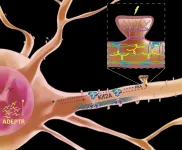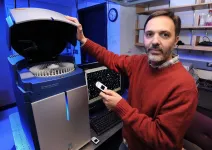The fate of the planet
Unconventional takes on pandemics and nuclear defense could protect humanity from catastrophic failure
2021-04-16
(Press-News.org) From engineered pandemics to city-toppling cyber attacks to nuclear annihilation, life on Earth could radically change, and soon. Scientists will forecast the fate of the planet at a END
ELSE PRESS RELEASES FROM THIS DATE:
Tarantula's ubiquity traced back to the cretaceous
2021-04-16
Tarantulas are among the most notorious spiders, due in part to their size, vibrant colors and prevalence throughout the world. But one thing most people don't know is that tarantulas are homebodies. Females and their young rarely leave their burrows and only mature males will wander to seek out a mate. How then did such a sedentary spider come to inhabit six out of seven continents?
An international team of researchers, including Carnegie Mellon University's Saoirse Foley, set out on an ancestry.com-like investigation to find the answer to this question. They looked to the transcriptomes, ...
On the pulse of pulsars and polar light
2021-04-16
Faced with the tragic loss of the Arecibo observatory in Puerto Rico and the often prohibitive cost of satellite missions, astronomers are searching for savvy alternatives to continue answering fundamental questions in physics.
At a END ...
Neural plasticity depends on this long noncoding RNA's journey from nucleus to synapse
2021-04-16
JUPITER, FL--Making memories involves more than seeing friends or taking photos. The brain constantly adapts to new information and stores memories by building connections among neurons, called synapses. How neurons do this--reaching out arm-like dendrites to communicate with other neurons--requires a ballet of genes, signaling molecules, cellular scaffolding and protein-building machinery.
A new study from scientists at Scripps Research and the Max Planck Florida Institute for Neuroscience finds a central role for one signaling molecule, a long, noncoding RNA that the scientists named ADEPTR.
Using a variety of technologies, including confocal and two-photon microscopy, they track ADEPTR's moves, watching as it forms, travels, amasses at the ...
A new guide for communicating plant science
2021-04-16
AMES, Iowa - A lot is riding on the continued advancement of plant sciences.
Take the food supply, for starters. Climate change and population growth will continue to pose challenges in the future, and crop production will require innovation and progress by plant scientists in order to keep pace. It isn't an overstatement to say that populations around the world will go hungry if plant science stagnates, said Gustavo MacIntosh, a professor in the Roy J. Carver Department of Biochemistry, Biophysics and Molecular Biology at Iowa State University.
"At the end of the day, either you eat plants or you eat food that ate plants," MacIntosh said. "Plants are the basis for the food we have."
MacIntosh predicts ...
The future of particle accelerators is here
2021-04-16
When the Electron Ion Collider received the go-ahead in January 2020, it became the only new major accelerator in the works anywhere in the world.
"All the stars aligned," said Elke-Caroline Aschenauer, Brookhaven National Laboratory Staff Scientist and a leader in developing the EIC plans. "We have the technology to build this unique particle accelerator and detector to do the measurements that, together with the underlying theory, can for the first time provide answers to longstanding fundamental questions in nuclear physics."
The EIC isn't the only Brookhaven project poised to reshape nuclear and particle physics. Forthcoming data from the Relativistic Heavy Ion Collider could finally detect the elusive chiral magnetic effect. Meanwhile, planned accelerators could run on sustainable ...
Simulations reveal how dominant SARS-CoV-2 strain binds to host, succumbs to antibodies
2021-04-16
LOS ALAMOS, N.M., April 16, 2021 -- Large-scale supercomputer simulations at the atomic level show that the dominant G form variant of the COVID-19-causing virus is more infectious partly because of its greater ability to readily bind to its target host receptor in the body, compared to other variants. These research results from a Los Alamos National Laboratory-led team illuminate the mechanism of both infection by the G form and antibody resistance against it, which could help in future vaccine development.
"We found that the interactions among the basic building blocks of the Spike protein become ...
New understanding of the deleterious immune response in rheumatoid arthritis
2021-04-16
Researchers within the Biomedicine Discovery Institute at Monash University have made a breakthrough in understanding the role played by high-risk immune genes associated with the development of rheumatoid arthritis (RA).
The findings, published in Science Immunology, were the result of a seven-year collaboration led by Monash University, involving Janssen Research and Development, USA and the Karolinska Institute, Sweden.
Certain immune system genes, called Human Leukocyte antigen (HLA)-DR4, cause an increased susceptibility to RA. In this study, using mice genetically ...
The Trojan-Horse mechanism: How networks reduce gender segregation
2021-04-16
The social science literature has long viewed homophily and network-based job recruitment as crucial drivers of segregation. Researchers at Linköping University and ESADE, Ramon Llull University now show that this view must be revised. In their Science Advances article, they call attention to a previously unidentified factor, the Trojan-horse mechanism, which shows that network-based recruitment can reduce rather than increase segregation levels.
The segregation of labor markets along ethnic and gender lines is an important source of socio-economic inequalities. Therefore, the understanding the mechanisms that drive segregation ...
Science Advances publishes proteomics technology from Oblique Therapeutics AB
2021-04-16
Science Advances publishes proteomics technology from Oblique Therapeutics AB with a potential to bring several novel antibody medicines to large patient populations in multiple disease areas
Gothenburg, Sweden, April 16th, 2021 - Oblique Therapeutics AB, a Sweden-based biotech company, in collaboration with Karolinska Institutet (Stockholm, Sweden), Gothenburg University (Sweden) and several local biotechs published promising research results in the highly-acclaimed scientific journal Science Advances (AAAS) entitled: Rational Antibody design for Undruggable Targets using Kinetically Controlled Biomolecular ...
Female protective effect: Yale researchers find clues to sex differences in autism
2021-04-16
New Haven, Conn. -- It is well established that autism occurs much more frequently in boys than in girls, and that girls seem to have a greater resilience to developing the condition. It has been unclear, however, why that is.
In a new Yale-led study, researchers find that autism may develop in different regions of the brain in girls than boys and that girls with autism have a larger number of genetic mutations than boys, suggesting that they require a larger "genetic hit" to develop the disorder.
The findings appear in the April 16 edition of the journal ...
LAST 30 PRESS RELEASES:
Human adipose tissue: a new source for functional organoids
Metro lines double as freight highways during off-peak hours, Beijing study shows
Biomedical functions and applications of nanomaterials in tumor diagnosis and treatment: perspectives from ophthalmic oncology
3D imaging unveils how passivation improves perovskite solar cell performance
Enriching framework Al sites in 8-membered rings of Cu-SSZ-39 zeolite to enhance low-temperature ammonia selective catalytic reduction performance
AI-powered RNA drug development: a new frontier in therapeutics
Decoupling the HOR enhancement on PtRu: Dynamically matching interfacial water to reaction coordinates
Sulfur isn’t poisonous when it synergistically acts with phosphine in olefins hydroformylation
URI researchers uncover molecular mechanisms behind speciation in corals
Chitin based carbon aerogel offers a cleaner way to store thermal energy
Tracing hidden sources of nitrate pollution in rapidly changing rural urban landscapes
Viruses on plastic pollution may quietly accelerate the spread of antibiotic resistance
Three UH Rainbow Babies & Children’s faculty elected to prestigious American Pediatric Society
Tunnel resilience models unveiled to aid post-earthquake recovery
Satellite communication systems: the future of 5G/6G connectivity
Space computing power networks: a new frontier for satellite technologies
Experiments advance potential of protein that makes hydrogen sulfide as a therapeutic target for Alzheimer’s disease
Examining private equity’s role in fertility care
Current Molecular Pharmacology achieves a landmark: real-time CiteScore advances to 7.2
Skeletal muscle epigenetic clocks developed using postmortem tissue from an Asian population
Estimating unemployment rates with social media data
Climate policies can backfire by eroding “green” values, study finds
Too much screen time too soon? A*STAR study links infant screen exposure to brain changes and teen anxiety
Global psychiatry mourns Professor Dan Stein, visionary who transformed mental health science across Africa and beyond
KIST develops eco-friendly palladium recovery technology to safeguard resource security
Statins significantly reduce mortality risk for adults with diabetes, regardless of cardiovascular risk
Brain immune cells may drive more damage in females than males with Alzheimer’s
Evidence-based recommendations empower clinicians to manage epilepsy in pregnancy
Fungus turns bark beetles’ defenses against them
There are new antivirals being tested for herpesviruses. Scientists now know how they work
[Press-News.org] The fate of the planetUnconventional takes on pandemics and nuclear defense could protect humanity from catastrophic failure







